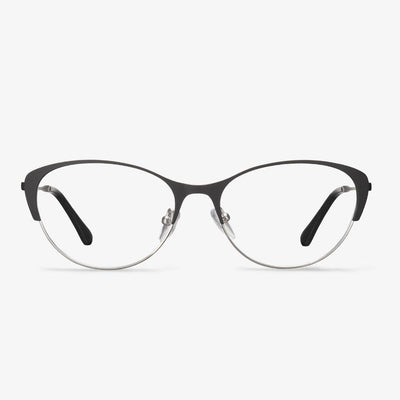Choose the frame according to the skin color
Generally, people with lighter skin tones are best to choose lighter-colored frames. For darker-skinned people, choose frames with darker colors. For example, people with white skin can choose the frame of soft pink, tortoise color, or golden silver, while people with darker skin color can choose red, black, or tortoise color.
Colored Clear sunglasses
The glasses style is distinctive, with an exaggerated outer edge and blue clear design. They show youth breath. The small eyebrow on the glasses side that shows faintly lets the whole look more stereoscopic. Relative to other colorless clear sunglasses, color clear glasses convey a strong youth breath. It is all color design that greatly enriched the color part of the overall image.
What to consider when buying eyeglasses?
You should think about that if the popular trend complies with your need for lens optics, the material, and its price, the famous brand. Check that if the producers have a professional cognition. The current frame is made of titanium, tungsten plate, carbon, metal, plastic, tortoiseshell, plastic, etc. Titanium is one of the best and most stable materials. The frames of other materials are easy to be corroded, discolored, worn, and deformed. No matter what kind of material you choose, it must be stable, safe, reliable, skin-friendly, light, strong, and non-deformable.
Why do people like wearing rimless glasses?
'Seamless connection, minimalist design' is the feature of the rimless glasses. Anytime, it is an invincible weapon integrating 'elegance, fashion, high-end, character', attracting countless attention. So in the European and American markets, it occupies 40%, most of which are the trendsetters who pursue fashion. In addition, rimless glasses will not cover too much of the face, which will show more reality to the wearer's style and temperament. The integration with the overall appearance is more perfect, and the wearer can be more flexible and casual in matching clothes. In addition, rimless glasses are more stylish and colorful.
How to Choose Glasses for Long Face?
Thick frame glasses: the third glasses for long faces we want to mention are the thick frame glasses. They can add width to your face for a more balanced look.
Aviator glasses: to balance the feature of long face, aviator glasses are a good choice, which includes a wider top and more narrow bottom, pairs perfectly with a long face.
Long faces have a long list of options when it comes to selecting the perfect pair of frames. Whether you are looking for a more polished, academic look or prefer a more casually cool style, you can find a pair of glasses making your personality pop.
Therefore, if you need a pair of glasses for long faces, you can try Koalaeye glasses. They are stylish and cheap. In addition, you can get a pair of prescription glasses online and the glasses will be mailed to you.
What Do Progressive Glasses Mean?
Progressive lenses, also called PALs, are the most popular multifocal lenses today. They offer an effective and great-looking vision solution for individuals with presbyopia. The main benefit of progressive lenses is that they do not have a visible line bisecting the lens, but rather a seamless and gradual change in power as you move down the lens.
Rather than two or three distinct zones, progressive lenses offer a smooth transition of focal powers that covers the total range of clear vision from close to far and every point in between.
Step-by-Step Glasses Size Guide
In this section, we will show you how to perform glasses measurements. But the first thing is to know what face shape you have. If you do not know, click here to have a check.
Then you need to know where to find the size measurement of your glasses. In general, you will find numbers that look like this 51-17-145 at the temples of your eyeglasses. Of course, these numbers come at different meanings.
The first number often refers to the lens width. Lens width is the horizontal diameter of the lens at its widest point. In optometry, another term is eye size.
The second number often means the bridge width. Bridge width is the part that joins the two lenses and sits over the nose. Some refer to this as the gap. The bridge width varies between 14 and 24 millimeters.
The third number often means the temple length. The temple is the arm that keeps the sunglasses on your face. That arm extends to the part that hangs on the ears. The length is usually 135, 140, or 145 millimeters.
Lens height measures the size of the lens vertically, that is from the top to the bottom of the lens. Although sizes may differ depending on the brand, the standard size is somewhere between 32 and 38 millimeters.











































